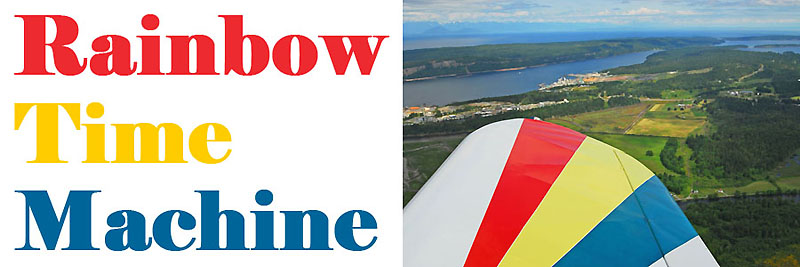
Vancouver Island, BC, Canada - June 2008

Meet CF-GFU, she's an Ercoupe 415-E, one of the most unique airplanes to come about during the post-war light airplane boom. Built in 1948, CF-GFU was originally owned
by 'Doc' Hess, a local pilot and friend of my grandparents. He was also the local Ercoupe distributor. Unfortunately Doc wasn't much of a pilot and CF-GFU ended up with more than
her share of wounds from Doc's demonstration flights. (Trevor McTavish)

Fast forward to 2001, when I rediscovered CF-GFU sitting on the ramp at Springbank. In the years that followed I contacted the owner and tried to arrange a flight but he
sold it before we managed to get together. Then I discovered it was in Victoria. Once again I contacted the owner and although we tried to get together it wasn't until 2008 that
I noticed it advertised for sale. Determined to fly this tiny piece of family history before it disappeared I made arrangements to meet the owner in Nanaimo, BC. (Trevor McTavish)

Travelling to Nanaimo, we made plans for a 30 minute flight up Vancouver Island to Qualicum Beach for a late lunch. (Trevor McTavish)

I was excited about my first Ercoupe flight, mostly because of its unique control arrangements. You see, Ercoupes didn't come with rudder pedals and were 'driven' more
like an automobile. Turn the yolk left and the plane turns left, turn it right and off you go to the right. On the floor in front of the left seat is a single pedal; not a rudder
pedal, but a car-like brake. It's all very simple and intuitive for the non-pilot and totally backwards and confusing for a conventional pilot. (Trevor McTavish)

As you can see, CF-GFU has been given some serious tender love and care since Doc Hess famously flew her through a farmer's barbwire fence back in the 1940s. Some people
might not like the rainbow colours, but I think they're rather striking, especially when you see how original elements like the Ercoupe nameplate have been incorporated. (Trevor
McTavish)

Getting inside the cabin and on to the bench seat presents half the challenge of flying an Ercoupe. I've been in cramped cockpits before including the infamous Luscombe
Silvaire, but I wasn't prepared for just how small the Ercoupe really is. Seated in the cockpit I had to either a) keep the canopy open to afford me some headroom or, because the
wind made the radio unreadable, b) slouch way down in the seat and fold my legs up underneath the instrument panel. Shoulder room was at a premium and I found myself with my left
arm tucked into the baggage compartment for most of the flight. Apparently these planes weren't intended for six foot tall pilots and even a wife or girlfriend might be
challenged by the cozy seating arrangement. (Trevor McTavish)

Airborne out of Naniamo. Performance was remarkably better than I expected for the tiny airplane. With two adult men and four hours of gas (about 20 gallons) the vertical
speed indicator was still reading 500 feet per minute. Okay, we were at sea level, but that's still pretty good for only 85hp. Cruising along, we were indicating 90mph at 2,500
feet. The top of my head, hat and headset protruded slightly above the canopy rim. (Trevor McTavish)

The owner wasn't comfortable passing complete control over to a strange pilot so he handled the takeoffs and landings. Crosswind control was completely different than in
a conventional airplane. Normally I'd start off with a strong aileron input to counter the wind and lessen the input as airspeed picked up and aileron authority increased. If one
was to do this in an Ercoupe you'd immediately find yourself steering off the side of the runway. Instead, a small correction was put into the yolk to keep the nose wheel
steering you down the runway. Once off the runway the crosswind was immediately countered by crabbing. (Trevor McTavish)

At Qualicum Beach I was glad the owner had chosen to perform the landing. The airstrip is beautiful, but it has tall pine trees lining the runway. With the wind blowing
across the field, the trees caused turbulence and bounced us around a bit. Normally I wouldn't have worried with the other planes I fly but with no experience flying without a
rudder I didn't want to end up putting someone else's plane on the grass. It was a typical crosswind landing for an Ercoupe; crab into the wind and plunk it down on the pavement.
Don't be fancy and don't worry about coming in sideways. (Trevor McTavish)

After lunch and a tour of the beautiful Qualicum Beach airport, we squeezed back aboard and took off south. It was now my turn to fly. Before takeoff I took a minute to
become acquainted with the steering by doing some figure eights on the tarmac.
Once airborne I started feeling my way around the Ercoupe's idiosyncrasies. For instance, the plane seemed to waddle its way through turbulence and although the interconnects are supposed to help coordinate your turns, they felt sloppy. A glance over at the turn and bank indicator showed that I was slipping and sliding my way through the air. I didn't try any really steep turns but even at 30-degrees of bank I could feel the plane slipping. I imagine that a real steep turn would only be an emergency manoeuvre in this plane. (Trevor McTavish)

I'm very grateful that Jeremy H. (CF-GFU's owner) gave me the opportunity to experience not only a flight in an Ercoupe (a rare airplane to find around home) but also to
be able to connect with a piece of my family's history. It's been 60 years since a McTavish first flew CF-GFU and probably 35 since anyone in my family had flown an Ercoupe.
Here's a photo of CF-GFU as my grandparents remembered it - on display at the Calgary Sportsman Show back in the late 1940s or early 1950s. (Trevor McTavish)